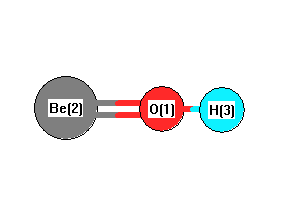Jump to
S1C2
Energy calculated at LSDA/3-21G*
| | hartrees |
|---|
| Energy at 0K | -89.566844 |
| Energy at 298.15K | -89.566476 |
| HF Energy | -89.566844 |
| Nuclear repulsion energy | 17.405600 |
The energy at 298.15K was derived from the energy at 0K
and an integrated heat capacity that used the calculated vibrational frequencies.
Geometric Data calculated at LSDA/3-21G*
Point Group is C∞v
Cartesians (Å)
| Atom |
x (Å) |
y (Å) |
z (Å) |
|---|
| O1 |
0.000 |
0.000 |
0.353 |
| Be2 |
0.000 |
0.000 |
-1.039 |
| H3 |
0.000 |
0.000 |
1.327 |
Atom - Atom Distances (Å)
| |
O1 |
Be2 |
H3 |
| O1 | | 1.3921 | 0.9739 |
Be2 | 1.3921 | | 2.3660 | H3 | 0.9739 | 2.3660 | |
 More geometry information
More geometry information
Calculated Bond Angles
| atom1 |
atom2 |
atom3 |
angle |
|
atom1 |
atom2 |
atom3 |
angle |
| Be2 |
O1 |
H3 |
180.000 |
|
Electronic energy levels
Charges, Dipole, Quadrupole and Polarizability
Charges from optimized geometry at LSDA/3-21G*
Charges (e)
| Number |
Element |
Mulliken |
CHELPG |
AIM |
ESP |
| 1 |
O |
-0.585 |
|
|
|
| 2 |
Be |
0.179 |
|
|
|
| 3 |
H |
0.406 |
|
|
|
Electric dipole moments
Electric dipole components in Debye
(What's a Debye? See section
VII.A.3)
| |
x |
y |
z |
Total |
| |
0.000 |
0.000 |
2.310 |
2.310 |
| CHELPG |
|
|
|
|
| AIM |
|
|
|
|
| ESP |
|
|
|
|
Electric Quadrupole moment
Quadrupole components in D Å
| Primitive |
|---|
| | x | y | z |
|---|
| x |
-12.058 |
0.000 |
0.000 |
| y |
0.000 |
-12.058 |
0.000 |
| z |
0.000 |
0.000 |
-11.083 |
|
| Traceless |
|---|
| | x | y | z |
|---|
| x |
-0.488 |
0.000 |
0.000 |
| y |
0.000 |
-0.488 |
0.000 |
| z |
0.000 |
0.000 |
0.976 |
|
| Polar |
|---|
| 3z2-r2 | 1.951 |
|---|
| x2-y2 | 0.000 |
|---|
| xy | 0.000 |
|---|
| xz | 0.000 |
|---|
| yz | 0.000 |
|---|
|
Polarizabilities
Components of the polarizability tensor.
Units are
Å
3 (Angstrom cubed)
Change units.
| |
x |
y |
z |
| x |
3.641 |
0.000 |
0.000 |
| y |
0.000 |
3.641 |
0.000 |
| z |
0.000 |
0.000 |
3.765 |
<r2> (average value of r
2) Å
2
| <r2> |
14.405 |
| (<r2>)1/2 |
3.795 |
Jump to
S1C1
Energy calculated at LSDA/3-21G*
| | hartrees |
|---|
| Energy at 0K | -89.566844 |
| Energy at 298.15K | -89.566464 |
| HF Energy | -89.566844 |
| Nuclear repulsion energy | 17.404973 |
The energy at 298.15K was derived from the energy at 0K
and an integrated heat capacity that used the calculated vibrational frequencies.
Geometric Data calculated at LSDA/3-21G*
Point Group is C∞v
Cartesians (Å)
| Atom |
x (Å) |
y (Å) |
z (Å) |
|---|
| O1 |
0.000 |
0.000 |
0.353 |
| Be2 |
0.000 |
0.000 |
-1.039 |
| H3 |
0.000 |
0.000 |
1.327 |
Atom - Atom Distances (Å)
| |
O1 |
Be2 |
H3 |
| O1 | | 1.3922 | 0.9738 |
Be2 | 1.3922 | | 2.3660 | H3 | 0.9738 | 2.3660 | |
 More geometry information
More geometry information
Calculated Bond Angles
| atom1 |
atom2 |
atom3 |
angle |
|
atom1 |
atom2 |
atom3 |
angle |
| Be2 |
O1 |
H3 |
180.000 |
|
Electronic energy levels
Charges, Dipole, Quadrupole and Polarizability
Charges from optimized geometry at LSDA/3-21G*
Charges (e)
| Number |
Element |
Mulliken |
CHELPG |
AIM |
ESP |
| 1 |
O |
-0.585 |
|
|
|
| 2 |
Be |
0.179 |
|
|
|
| 3 |
H |
0.406 |
|
|
|
Electric dipole moments
Electric dipole components in Debye
(What's a Debye? See section
VII.A.3)
| |
x |
y |
z |
Total |
| |
0.000 |
0.000 |
2.310 |
2.310 |
| CHELPG |
|
|
|
|
| AIM |
|
|
|
|
| ESP |
|
|
|
|
Electric Quadrupole moment
Quadrupole components in D Å
| Primitive |
|---|
| | x | y | z |
|---|
| x |
-12.058 |
0.000 |
0.000 |
| y |
0.000 |
-12.058 |
0.000 |
| z |
0.000 |
0.000 |
-11.083 |
|
| Traceless |
|---|
| | x | y | z |
|---|
| x |
-0.487 |
0.000 |
0.000 |
| y |
0.000 |
-0.487 |
0.000 |
| z |
0.000 |
0.000 |
0.975 |
|
| Polar |
|---|
| 3z2-r2 | 1.950 |
|---|
| x2-y2 | 0.000 |
|---|
| xy | 0.000 |
|---|
| xz | 0.000 |
|---|
| yz | 0.000 |
|---|
|
Polarizabilities
Components of the polarizability tensor.
Units are
Å
3 (Angstrom cubed)
Change units.
| |
x |
y |
z |
| x |
3.641 |
0.000 |
0.000 |
| y |
0.000 |
3.641 |
0.000 |
| z |
0.000 |
0.000 |
3.764 |
<r2> (average value of r
2) Å
2
| <r2> |
14.406 |
| (<r2>)1/2 |
3.795 |
